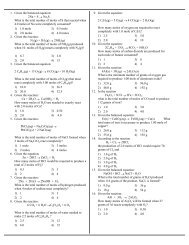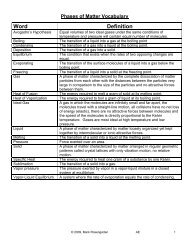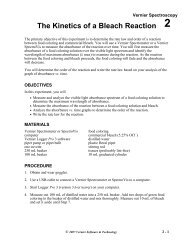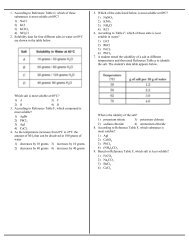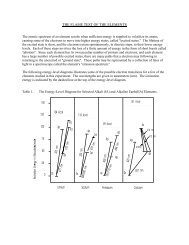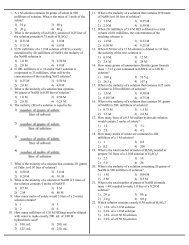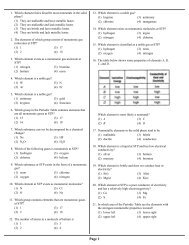Kinetics, Thermodynamics and Equilibrium - Revsworld
Kinetics, Thermodynamics and Equilibrium - Revsworld
Kinetics, Thermodynamics and Equilibrium - Revsworld
You also want an ePaper? Increase the reach of your titles
YUMPU automatically turns print PDFs into web optimized ePapers that Google loves.
4) Will A Reaction Happen On Its Own Once Started? (HW: p. 30, 31)<br />
Objective: You will describe changes in enthalpy <strong>and</strong> entropy as being favored or unfavored, <strong>and</strong> use that information<br />
to determine whether a reaction will be spontaneous always, never, at high temperature or low temperature.<br />
SPONTANEOUS CHEMICAL CHANGES - reactions that proceed of their own accord once initiated. These reactions<br />
are h<strong>and</strong>y for manufacturing processes! Imaginewhat will cost less money to make; a product formed from a<br />
reaction that happens all by itself once started, or a product that requires a constant addition of energy to<br />
manufacture? If you can find a spontaneous reaction to make your product, you can charge less for itor invest the<br />
difference into research <strong>and</strong> development into new products!<br />
In order for a chemical reaction to be spontaneous, there has to be a balance between two factors:<br />
1) ENTHALPY - the heat content of the system. Nature favors reactions that undergo a decrease in enthalpy.<br />
When you let go of a ball that you hold in your h<strong>and</strong>, it falls. This is a spontaneous decrease in enthalpy.<br />
Nature favors reactions that have a net decrease in PE, so EXOTHERMIC reactions are favored. Most exothermic<br />
reactions are spontaneous. Most endothermic reactions are nonspontaneous, <strong>and</strong> they require a constant input of<br />
energy to keep them going.<br />
This reaction is exothermic, <strong>and</strong> is therefore FAVORED.<br />
This reaction is endothermic, <strong>and</strong> is therefore UNFAVORED.<br />
Imagine you are on a bike at the top of a hill. Once you kick off, you can go down the hill with no further input of<br />
energy. This is a spontaneous exothermic change.<br />
Imagine you are on a bike at the bottom of a hill. To get to the top, you have to continuously put in energy. If you stop,<br />
you will slide back to the bottom of the hill. This is a nonspontaneous endothermic change.<br />
Once a match is struck, it continues burning on its own, without any further input of energy, until the reactants have<br />
completely reacted. This is a spontaneous exothermic change.<br />
To decompose water into hydrogen <strong>and</strong> oxygen (as done in an earlier demo) requires constant input of energy. Once<br />
energy input is stopped, the reaction will stop <strong>and</strong> ,in many cases, reverse itself.<br />
© 2009, Mark Rosengarten AE 14






